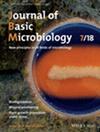特别关注:革兰氏阳性细菌的潜力。
IF 3.5
4区 生物学
Q2 MICROBIOLOGY
引用次数: 0
摘要
本文章由计算机程序翻译,如有差异,请以英文原文为准。
Special Focus: The Potential of Gram-Positive Bacteria
求助全文
通过发布文献求助,成功后即可免费获取论文全文。
去求助
来源期刊

Journal of Basic Microbiology
生物-微生物学
CiteScore
6.10
自引率
0.00%
发文量
134
审稿时长
1.8 months
期刊介绍:
The Journal of Basic Microbiology (JBM) publishes primary research papers on both procaryotic and eucaryotic microorganisms, including bacteria, archaea, fungi, algae, protozoans, phages, viruses, viroids and prions.
Papers published deal with:
microbial interactions (pathogenic, mutualistic, environmental),
ecology,
physiology,
genetics and cell biology/development,
new methodologies, i.e., new imaging technologies (e.g. video-fluorescence microscopy, modern TEM applications)
novel molecular biology methods (e.g. PCR-based gene targeting or cassettes for cloning of GFP constructs).
 求助内容:
求助内容: 应助结果提醒方式:
应助结果提醒方式:


